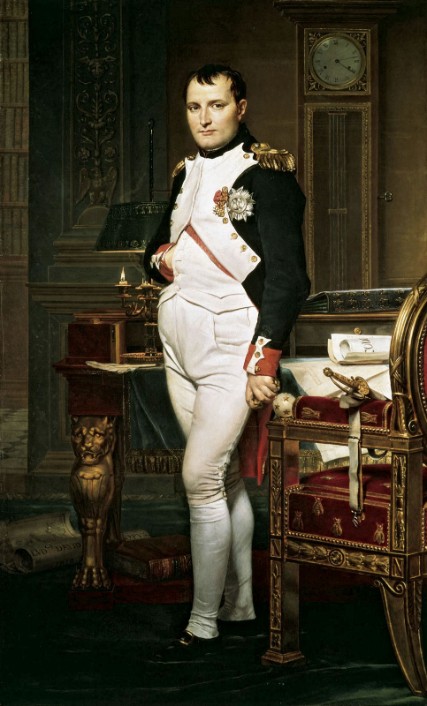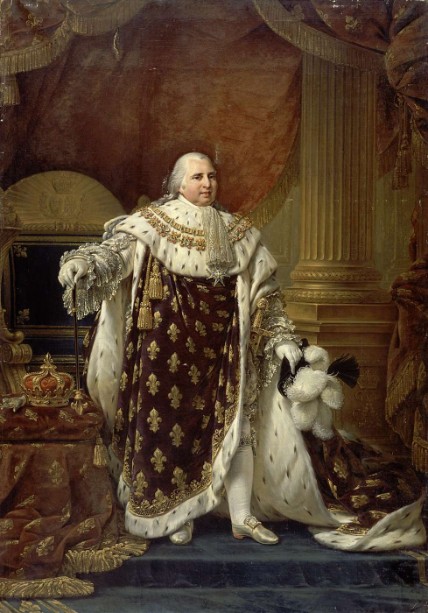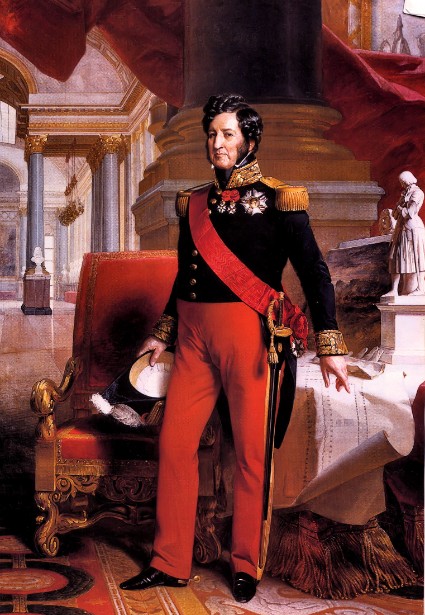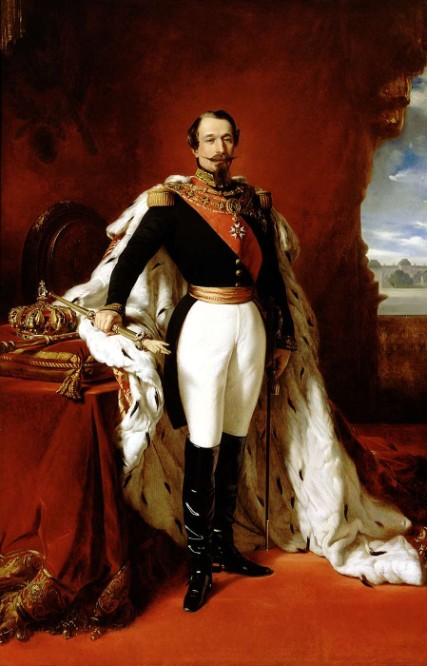Historical Context
The First French Empire:
After a number of military victories, Napoleon declared himself the Emperor of France. Throughout his ceaseless military campaigns for the domination of Europe, Napoleon I gained an immense amount of territory for France, including the former Holy Roman Empire. Napoleon I continued to spread his influence throughout Europe and North Africa. However, the tide began to turn as a number of problems arose. The effects of the French Revolution continued to become manifest as a rebellion between the slaves and the slave-owners broke out in French-controlled territory. Napoleon I tried unsuccessfully to stifle the revolt. In addition to this loss, Napoleon I sold a massive amount of territory in North America to the President of the United States, Thomas Jefferson, known as the Louisiana Purchase. Napoleon I, who was facing a downward turn in his war efforts and the drain of resources, was desperate for the money, hence the loss of territory, including the French colony in Louisiana, to the United States. The countries opposing Napoleon eventually defeated him, leading to the abdication and exiling of Napoleon I to the island of Elba in 1814. However, Napoleon I escaped his banishment and returned to regain control of France and then Europe. Napoleon was soundly defeated in the Battle of Waterloo by the British in 1815 and forced back into exile, this time on the island of St. Helena. Napoleon I died in exile in 1821. In the portrait to the right, Napoleon utilizes symbols of the Bourbon monarchy and from the Roman Empire. What is the significance of the use of the wreath of laurel leaves (which symbolize victory) instead of a crown? What precedent does this set? Is this image more effective than previous royal portraits? In what ways is this painting more powerful or viscerally impacting than other portraits? Another example of a coronation portrait can be found here. What messages did these images send to Europe during his reign? Is Napoleon I overconfident in assuming he will be victorious, or that his empire will rival the Romans? Is his assumption any different from Louis XIV's comparison to Apollo, Greek god of the Sun? | Emperor Napoleon Bonaparte (1804-1815)  Napoleon Enthroned, Jean-Auguste-Dominique Ingres, 1806, Musée de l'Armée, Paris |
 Napoleon at Saint Bernard Pass, Jacques-Louis David, 1800, Musée National du Château de Versailles | The Romantic portrayal of Napoleon I details a military campaign for the domination of Europe. What message does this painting send to the viewer? Napoleon I, like his Bourbon predecessors, utilizes the so-called equestrian portrait. In what ways is this equestrian portrait more effective than that of the monarchy's? Could it be because this was a real event and Napoleon I was a real soldier? How does this painting provide support for Napoleon I? Does this painting offer confidence in Napoleon I's ability to rule effectively? |
Due to Napoleon's extensive military campaigns, how is this stark image, nearly devoid of ornamentation, be more effective than the images of the Bourbon monarchs, swords and all? Does this painting present the leadership of France as more confident than the royal portraits portrayed? Or is the image of Napoleon enough to boost French moral, even without the traditional symbols of royalty and power? Especially without the symbols? Does this painting make Napoleon I seem more human and less like a God-appointed leader? Does the simple backdrop, as opposed to the Bourbon formula of classical backgrounds, send a message to the viewer? What message? Two years after the painting was finished, Napoleon was exiled on Elba. What would this painting come to represent after Napoleon's defeat? |  Napoleon in His Study, Jacques-Louis David, ca. 1812 |
The House of Bourbon, Restored:
King Louis XVIII (1815-1824)  Antoine-Jean Gros, ca. 1817, Musée national du Château de Compiègne | When Louis XVII died in prison in 1795, his uncle, Louis XVIII became the titular king. However, Louis XVIII went into exile during the Revolution and Napoleon's reign as Emperor. After the defeat of Napoleon, Louis XVIII was returned to the throne, restoring the House of Bourbon. However, the Senate stipulated that Louis XVIII accept the constitution provided. Louis XVIII, when restored, promised to reduce taxes while managing the deficit left behind by Napoleon. In actuality, the king backed out of his promises after being placed on the throne. In 1815, Napoleon escaped from his exile on the island of Elba and for one hundred days he set about reconquering France. In the infamous Battle of Waterloo, Napoleon was defeated and sent back to exile by the British troops led by the Duke of Wellington. During this time, Louis XVIII fled Paris in search of refuge. After the cowardly actions of Louis XVIII during the Hundred Days, his position in governing France greatly diminished, left instead in the hands of a council of ministers. As Louis XVIII was childless, the question of succession lay in doubt. Ultimately, the throne was left to Louis XVIII's youngest brother, the future Charles X. In the portrait to the left, Louis XVIII is adorned with the traditional attire of the Bourbon monarchs, complete with a white, powdered wig. what is the significance of the color red as opposed to the traditional blue? This portrait is remarkably similar to that of Louis XVI's before his execution. After the reign of Napoleon and the emphasis on the military, how does this portrait of Louis XVIII seem like a step backwards? After the French Revolution, would this image of Bourbon finery be frightening and unwelcome? How might this image come to represent French power again after the defeat of Napoleon? |
During the Revolution, Charles X, like other nobles and Bourbons who escaped France, was living in exile. The restoration of the monarchy brought Charles X back from England (where he had been living in exile) to France. With the death of his older brother, Louis XVIII, Charles X became king. Charles X's first order of business was to grant more power to the nobility, making up for the unseemly behavior of the people during the Revolution. Charles X took an active role in government, suggesting legislation to Parlement on a regular basis. During Charles X's reign the French took control of Algeria in order to protect French trade in the Mediterranean. Charles X was extremely unpopular and in July 1830, the French people stage another revolution against the monarchy. In response, Charles X abdicated leaving his grandson, Henri, the ten-year-old duc de Bordeaux as the next ruler. Louis-Philippe, duc d'Orléans, reigned for ten days as Regent before Parlement appointed Louis-Philippe the next ruler due to his liberal tendencies. Charles X returned to exile, dying in 1836 in a small town in modern-day Slovenia. In Charles X's royal portrait to the right, the king is clad in ermine-trimmed robes covered in fleur-de-lys. Picture with the king is a crown, another symbol of royal rule. After Louis XVIII, how might this image have become corrupted? After removing the Bourbons from the throne in 1789, then reestablishing their rule in 1815, what does this image say to the people? Noting that both of the latest Bourbon monarchs were terribly unpopular, what feelings does this painting illicit? | King Charles X (1824-1830)  François-Pascal Simon Gérard and Henry Bone, ca. 1829, Metropolitan Museum of Art |
King Louis-Philippe I (1830-1848) "The Citizen-King"  Franz Xaver Winterhalter, ca. 1839, Palace of Versailles | As a member of the nobility like Louis XVIII and Charles X, Louis-Philippe I fled into exile during the Revolution and Napoleon I's reign. Louis-Philippe I was a member of the House of Orléans, a branch of the House of Bourbon through the brother of Louis XIV. However, with the reestablishment of the House of Bourbon to the throne, Louis-Philippe I returned to France. Due to the abdication of Charles X, Louis-Philippe I became the Parlement appointed leader of France. The establishment of a constitutional monarchy meant that Louis-Philippe I did not have access to the amount of power as previous Bourbon monarchs held. Louis-Philippe I took the title "King of the French," first used by Louis XVI, and subsequently became known as the "Citizen-King" because of lack of absolute rule and decadent lifestyle. In the beginning of his reign, the king was well-loved and popular, however, his government, namely Parlement, became more pretentious and more prone to support monarchical decisions. The government gave more power to the wealthy, steadily increasing the income gap between the successful and the poor of France. The economic downturn spurred a revolt. The Revolution of 1848 deposed Louis-Philippe in favor of a Republic. The portrait to the left depicts Louis-Philippe I in military dress. As a young man, Louis-Philippe I was very involved in warfare. While Napoleon I is also depicted in military dress, does Louis-Philippe I's portrayal seem less pretentious, since he was known as the "Citizen-King" as opposed to Emperor? How might this painting offer the French people confidence in their protean government? |
The Second French Republic:
Charles-Louis was the heir and nephew of Napoleon I. In 1848, Charles-Louis was elected President of the Second French Republic. The French public (and the Royalists) thought that Charles-Louis could restore stability to the French government and prevent Communism from spreading throughout France. Charles-Louis was elected in a landslide victory. The National Assembly, at this time curiously filled with Royalists, had ratified a constitution prohibiting a president to go for reelection after his term ended. Charles-Louis sought to be his own successor and tried to have the constitution amended. The National Assembly refused. In response, Charles-Louis, in 1851, staged a coup d'état and established himself as the new Emperor of the new Second French Empire that he had just created. In 1852, the Republic officially ended and with his ascension to Emperor, Charles-Louis became Napoleon III. Like his uncle before him, Charles-Louis utilizes the military uniform to illustrate his military and leadership prowess. However, unlike his uncle, Charles-Louis also includes a crown, to assert his right to rule. In addition to the uniform, Charles-Louis is wearing a ermine robe, a traditional symbol of royal authority. Is this image of Charles-Louis more effective than Napoleon I's? How does this image represent the strength of France? | President Charles-Louis Napoleon Bonaparte (1848-1852)  |
The Second French Empire:
Emperor Napoleon III (1852-1870) Formerly Charles-Louis Napoleon Bonaparte  Franz Xaver Winterhalter, ca. 1855, Museo Napoleonico, Rome | Napoleon III sought to return France to its former glory. He did this through an intense focus on foreign policy, often allying France with other European countries in war. In this way, Napoleon III was able to hold onto French interests in Eastern Asia. However, Napoleon III's foreign policy was incredibly expensive, making his position as ruler tense. In order to regain popularity, Napoleon III tried to make liberal concessions to Parliament and to the public, however these concessions did not go as planned, ultimately making Napoleon III more unpopular. Napoleon III tried a different tactic. Under his leadership, France became more industrialized and modern. In order to counteract the debt being racked up due to foreign policy, Napoleon III had a distinct economic agenda that he set about instituting. One of the most important legacies of Napoleon III's reign was the building of the Suez Canal in Egypt. The canal facilitated trade between Europe and the East (the Middle East and Asia). The Franco-Prussian War (1870-1871) ended the reign of Napoleon III and the Second French Empire. France was defeated by Otto van Bismarck of Germany. The Emperor was captured. France was then declared a Republic once more. Napoleon III died in 1873 filled with regret over his defeat. Napoleon III was the only person to be the titular king and President. While Louis-Philippe was the last King of France, Napoleon III was its last monarch. In the portrait to the left, Napoleon III combines the image of Napoleon I and the Bourbon monarchy. Napoleon III is wearing a military uniform and the traditional Bourbon regalia. Compare this painting to Napoleon I's. How are the messages similar? Different? How does the combination of the images of Napoleon I and the Bourbon monarchy serve to present an image of stability? Or does it? |
The First Democratic Republic and Unification of France 1871-Present
~All dates are dates of reign Format: Title (if available), Artist(s), Date, Current Location